The Pacific Northwest and steelhead are inseparable. It’s impossible to imagine the state of Washington without its summer and winter steelhead runs.
And if you don’t know your way around this state, it can be equally impossible to locate any decent steelhead rivers. That’s why I decided to write up this complete guide on steelhead fishing in Washington.
It includes detailed information on topics such as:
- The best steelhead rivers and tributaries in Washington
- The best times of year to catch Washington State steelhead
- The best steelhead fishing charters in Washington
- Fishing reports, record catches, regulations, and licenses for steelhead fishing in Washington
If you’re planning a steelhead fishing trip to the incredible Pacific Northwest and want valuable tips, all you have to do is keep reading!
PRO TIP: Need to gear up for your upcoming salmon fishing adventure? Then check out this quality equipment on Amazon. It’s very cost-effective, durable, and will land you plenty of trophy salmon!
Where to Catch Steelhead in Washington?
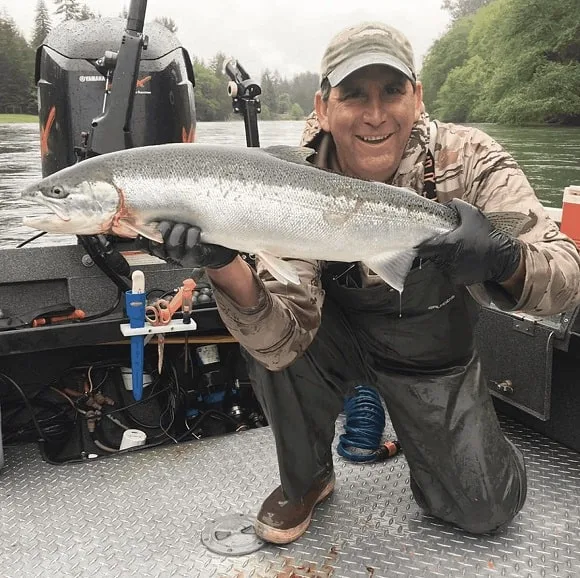
Washington state has plenty of salmon and trout rivers. So many that it would be close to impossible to fit them all into one article.
The state has always been a Mekka for steelhead anglers, even if some rivers and tributaries have now lost their former glory.
Luckily for us anglers, though, there are still plenty of really excellent wild and hatchery-based fisheries out there, making Washington one of the United States’ top steelhead destinations!
Here is a list of some of the state’s top summer and winter steelhead rivers and tributaries:
Skykomish River (Summer and Winter)
The Skykomish River is one of the best steelhead rivers in the northwestern parts of Washington, as it produces very decent numbers of both summer and winter-run fish.
It is flowing through both Snohomish and King County and drains into the Snohomish River, which, in turn, empties into Port Gardner Bay on Possession Sound (which is part of Puget Sound).
The Sky River, which it is also referred to, is 29 miles long and a top-rated steelhead destination in this part of the state.
Additionally to its wild winter stocks, the river has been stocked with plenty of summer smolts, making it very well possible to catch several fish during a day trip.
The Sky is best suited for fly fishing.
Hoko River (Winter)
The Hoko River is a highly productive river system of winter-run steelhead.
It’s located on the northern Olympic Peninsula and empties into the Salish Sea near the Hoko River State Park.
With its 48 miles, it’s a fairly long river system that offers its winter runs plenty of spawning habitats and the anglers many great stretches and spots.
The lower stretches of the Hoko can be fished with both fly, lure, or float, while the upper Hoko is catch and release fly fishing only.
Bogachiel River (Winter)
The Bogachiel is yet another Olympic Peninsula river that many anglers regard as a regular steelhead paradise.
Located in the northwestern parts of the peninsula, it flows into the Quillayute River, which empties into the Pacific Ocean at La Push.
The direct access from the Pacific means plenty of wild winter-run steelhead!
In fact, the Bogachiel sees very large and healthy winter runs that, in good years, can see up to 20,000 returning fish.
Additionally, there are about 50,000 hatchery-raised steelhead to be found here.
The Bogachiel River is a beginner-friendly steelhead water and is suited for fishing with fly, spinning, or float gear.
Calawah River (Summer and Winter)
The Calawah is located in the same area of the Olympic Peninsula as the Bogachiel River and is actually a tributary of the Bogachiel, flowing into it near the town of Forks.
Together, these two rivers are home to some of Washington’s biggest and meanest steelhead and two highly popular fishing destinations.
However, unlike the Bogachiel, the Calawah River is not as easy to fish and demands some advanced skills from the angler, mainly because of its many rapids and crystal clear water.
But should you be able to master this river, you’re in for some fantastic fights and giant steelhead!
The Calawah has many easy-access points, can be fished from both bank and boat, and is best suited for float fishing with smaller baits.
Wynoochee River (Summer and Winter)
The Wynoochee is one of the hottest steelhead rivers in the southern parts of Washington’s Olympic Peninsula.
It is a tributary of the Chihalis River and empties into it near Montesano that stretches roughly 60 miles through Grays Harbor County.
The Wynoochee produces excellent summer and winter runs and can be fished from June to March.
It is well-suited for both drift boat fishing and bank fishing.
Most anglers fishing the river’s upper stretches will stick to flies, while the lower sections offer great opportunities for both float fishing and spinning.
Skookumchuck River (Winter)
If you follow the Chihalis River southbound, you’ll eventually get to yet another of its tributaries; the Skookumchuck River.
This river provides excellent opportunities for late winter and early spring steelhead fishing.
The Skookumchuck enters the Chihalis River between the cities of Centralia and Fords Prairie and flows through both Lweis and Thurston County.
There are plenty of productive spots along the river, but most anglers will target the area east of the town of Bucoda, below the Skookumchuck dam near the state hatchery facility.
Most steelhead on this river are either caught on flies or float rigs.
Cowlitz River (Summer and Winter)
Of course, this list wouldn’t be complete without a Columbia River tributary!
The perhaps most productive one of these is the Cowlitz River, which flows through Lweis and Cowlitz County and empties into the lower Columbia River near Kelso and Longview in the southern parts of Washington.
The Cowlitz has decent summer and winter runs, primarily thanks to the half a million or so summer and winter smolts planted at Blue Creek further up the river.
While the summer runs can last through August, the Cowlitz River’s winter runs will generally happen quite late, and you can often expect decent fishing well into April.
Some of the river’s tributaries, including the North and South Folk Toutle River or the Coweeman River, can be pretty productive as well.
Cowlitz steelhead can be caught on both flies, lures, and light float rigs.
When Is the Best Time to Fish for Steelhead in Washington?
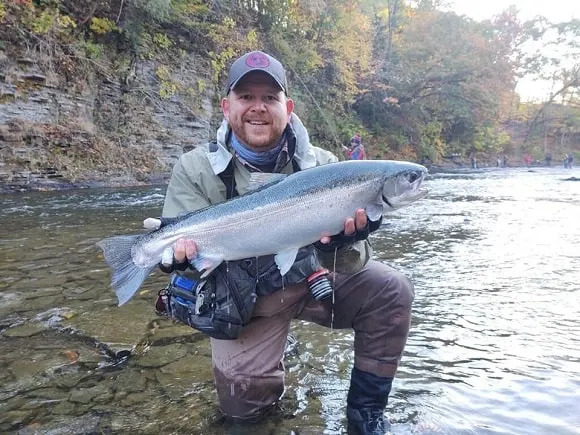
While you can target steelhead during most months of the year on many rivers, both the summer and winter runs will have their peak periods during which the fishing is considered most productive.
Of course, these periods will change slightly from river to river, but overall, the catch rates show that the following summer and winter months are the best for steelhead fishing in most rivers in Washington:
Summer-Run Steelhead
Summer-run steelhead will make their way upstream in most rivers from May through September, and the best time to target Washington summer steelhead is generally during both July and August.
But as they will enter the rivers already in May and basically won’t spawn until December or January, you can, theoretically, catch them during the entire period between May and January.
It’s just that they will be most active and hungry during July and August, given the warmer water temperatures and the abundance of forage in the rivers.
Winter-Run Steelhead
Washington’s wild winter steelhead will start their runs sometime in October or early November, and the best time to fish for them during the winter is from January through March.
Of course, similarly to the summer-run steelhead, the winter steelhead can also be found in the rivers for many more months and can technically be targeted from November through May, or sometimes even early June.
However, hitting them in mid-winter is almost always most fruitful!
For one thing, there will be considerably more fish now than at the start of their runs during the fall.
For another, the months April and May can be much trickier, as they will fall right into the fish’s spawning season.
So as you can see, many of Washington’s rivers hold steelhead during most months of the year, and if you don’t care whether you catch summer or winter fish and are willing to target the right rivers, you can practically catch steelhead year-round here!
This holds especially true for many of the Olympic Peninsula’s river systems.
How to Fish for Steelhead in Washington?
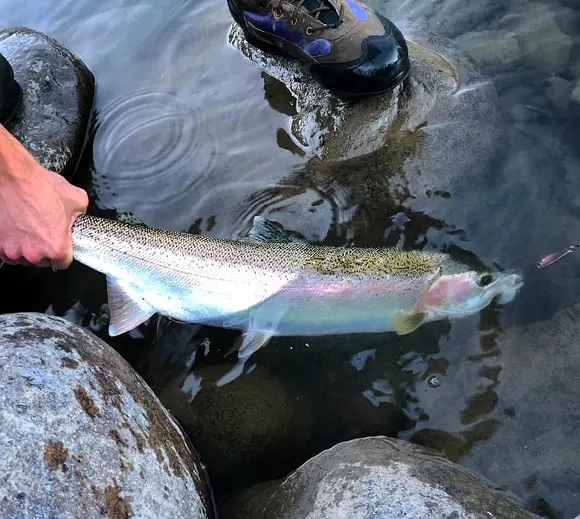
Washington steelhead can be caught using a variety of fishing techniques. Most anglers will prefer either float, spin, or fly fishing for them.
All three techniques have their charm and advantages, and if you know when and in what conditions to fish these methods, you will most likely end up catching more fish.
Float or Bobber Fishing
Float or bobber fishing is the most widely used technique for steelhead in rivers.
It’s a straightforward approach that can be very productive in many waters.
Fishing a slip bobber rig is easy and fun, making this fishing technique the best for beginners!
Common baits for float fishing for steelhead include:
- salmon eggs (natural or artificial)
- worms
- shrimp
- yarn
- micro jigs
- minnows
You can float fish from shore and boat (also called drift boat fishing or side drifting). Both approaches can give your bait the perfect natural presentation in the river.
GEAR TIP: You can check out this float rod and reel combo on Amazon. It’s perfect for both steelhead and salmon!
- Rod: 10′ Okuma Celilo Graphite
- Reel: Pflueger President XT40
Spin Fishing
Next up is spin fishing, a versatile and very active way of targeting steelhead.
As you constantly cast out and retrieve your lure, you can cover a lot of water, increasing your chances of catching more fish.
Spin fishing can be especially productive in somewhat warmer water temperatures when the fish are hunting and feeding more actively.
Some of the best spin fishing lures for Washington steelhead include:
- spinners
- spoons
- plugs
- crankbaits
GEAR TIP: Need to gear up for the season? Take a closer look at this popular steelhead spin fishing gear on Amazon!
Fly Fishing
And then there is the art of fly fishing for steelies.
This is a great and exciting way of catching fish, but as this fishing technique is a little more advanced than the other two, it’s not really a first choice for beginners.
However, if you know how to swing a fly, presenting it on the surface (for summer steelhead) or beneath it (for winter steelhead) can be an absolute game changer!
While you can use wet and dry flies, nymphs, or streamers, it’s really more about the pattern! Find out what patterns work on your target river, and you’ll be successful!
GEAR TIP: Check out this awesome rod and reel combo on Amazon. It’s very decently priced and the perfect entry-level gear! And don’t forget your waders!
- Fly Rod and Reel Kit: TFO NXT Black Label 4-piece
- Waders: Tidewe 1600g Insulated Waders
Can You Catch Steelhead at Night in Washington?
It is legal in the state of Washington to fish for steelhead at night.
While most smaller rivers and tributaries will allow nighttime fishing, some of the bigger river systems (such as the Columbia) can, however, have a night closure.
Make sure always to check the regulations and emergency rule changes (if there are any) of the river you’d like to fish before heading out!
You can find more detailed information on regulations and emergency rule changes via the Washington State DFW’s regulation section.
PRO TIP: Night fishing for steelhead can be highly productive (and addictive) during the summertime when the fish are most active and willing to feed. Catching a midnight steelhead on a warm Washington summer night is a very special experience, so make sure to try it out!
Steelhead Fishing Reports for Washington State
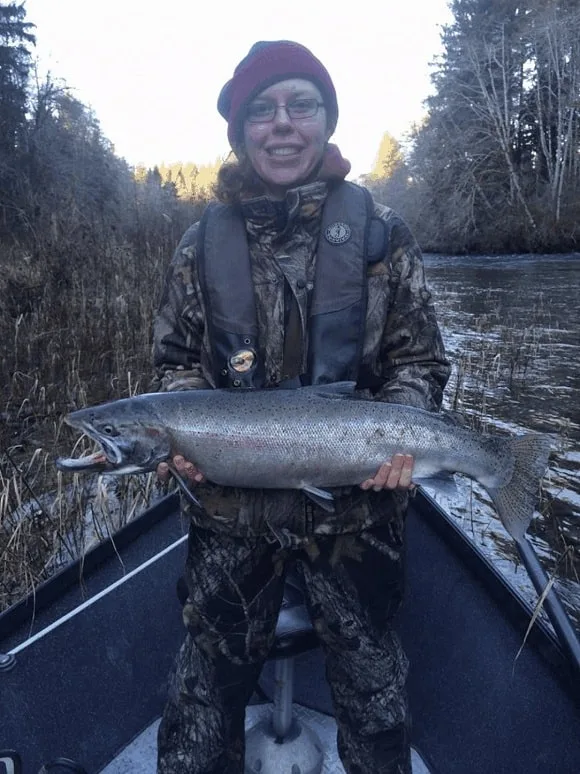
The Washington Department of Fish and Wildlife publishes river catch reports of steelhead and salmon. Please note, however, that these reports are being posted irregularly.
Additionally, WashingtonFishReports.com releases up-to-date steelhead catch reports from various rivers in the state.
Another reliable source can be various Pacific Northwest Steelhead groups on Facebook, as they often contain valuable information and fishing reports from local anglers.
Here are a few large and active FB communities if you want to check them out:
Washington State Steelhead Fishing Regulations
Before you start your Washington steelhead fishing adventure, make sure to read the state’s recreational fishing regulations and the special rules for fishing in Washington’s coastal rivers and tributaries very closely.
Regulations and season lengths can vary quite a bit from river to river, so make sure to read them thoroughly and keep yourself updated.
You can find the state’s current sport fishing regulations and the special rules for rivers and tribs via the Washington Department of Fish and Wildlife website’s fishing regulations section.
Do You Need a Fishing License in Washington?
All residents and nonresidents age 15 and older need to purchase a fishing license to fish for salmon and trout species in Washington waters.
If you target salmon or steelhead, your license will include a catch record card to track your harvest.
Please be aware that all anglers (even those under 15) must carry a catch record card when fishing and that every card must be returned to the Washington DFW by the appropriate deadline, catch or no catch.
Please visit the Washington DFW’s fishing license section for more detailed information on fishing license rules.
You can purchase your Washington state fishing license directly online via the Washington DFW’s online licensing system.
How Big Do Steelhead Get in Washington?
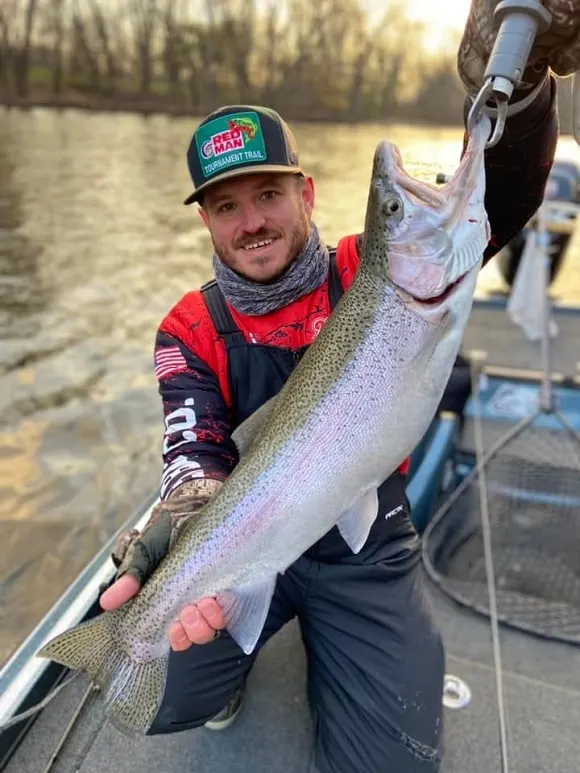
Both summer and winter-run steelhead could once reach enormous sizes, weighing well over 40lb. Over the last two decades or so, both their numbers and sizes have unfortunately gone somewhat down.
Nowadays, the average Washington state steelhead will weigh somewhere between 8 and 12lb.
However, trophy-sized steelhead between 20 and 30lb are still being caught annually and in various rivers all over the state.
What Is the Biggest Steelhead Ever Caught in Washington?
As both summer and winter-run stocks are so commonly found in Washington, there are not one but two state records for steelhead.
The Washington state record for summer-run steelhead is a giant fish of 35.06lb that angler Gilbert Pierson caught on Snake River in 1973 (back when the Snake was still a highly productive steelhead water).
The state record for winter-run steelhead is a fish of 32.75lb. Angler Gene Maygra caught this fish on the Lewis River in 1980 (the Lewis also used to see better days).
Are Steelhead Native to Washington State?
Most of the winter-run stocks of Western Washington consist of native steelhead, or rather of coastal rainbow trout (Oncorhynchus mykiss).
These rainbow trout have inhabited the state’s coastal rivers and tributaries since the end of the ice age and have, at some point, begun to head out to the Pacific ocean.
As these fish return to their native rivers for their annual spawning, they have hence become anadromous (meaning that they migrate upriver from the sea to spawn).
This anadromous coastal rainbow trout mostly goes under the name of steelhead or steelhead trout.
On the other hand, none of the summer-run steelhead are native to Washington but have instead been introduced to various river systems via state hatcheries to increase the state’s commercial and recreational fishing activity.
Related Steelhead Fishing Articles
- Steelhead Fishing in Michigan (A Helpful Guide)
- Where is the Best Steelhead Fishing in Upstate New York?
- Rainbow Trout vs. Steelhead (What’s the Difference?)
Featured image courtesy of Kevin Kuhn

